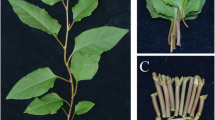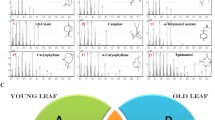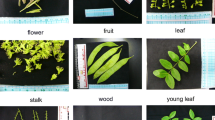Abstract
Ginkgo biloba is one of the oldest living tree species and has been extensively investigated as a source of bioactive natural compounds, including bioactive flavonoids, diterpene lactones, terpenoids and polysaccharides which accumulate in foliar tissues. Despite this chemical diversity, relatively few enzymes associated with any biosynthetic pathway from ginkgo have been characterized to date. In the present work, predicted transcripts potentially encoding enzymes associated with the biosynthesis of diterpenoid and terpenoid compounds, including putative terpene synthases, were first identified by mining publicly-available G. biloba RNA-seq data sets. Recombinant enzyme studies with two of the TPS-like sequences led to the identification of GbTPS1 and GbTPS2, encoding farnesol and bisabolene synthases, respectively. Additionally, the phylogenetic analysis revealed the two terpene synthase genes as primitive genes that might have evolved from an ancestral diterpene synthase.







Similar content being viewed by others
References
Bohlmann J, Meyer-Gauen G, Croteau R (1998a) Plant terpenoid synthases: molecular biology and phylogenetic analysis. Proc Natl Acad Sci USA 95:4126–4133
Bohlmann J, Crock J, Jetter R, Croteau R (1998b) Terpenolid-based defenses in conifers: cDNA cloning, characterization, and functional expression of wound-inducible (E)-α-bisabolene synthase from grand fir (Abies grandis). Proc Natl Acad Sci USA 95:6756–6761
Chamberlain CJ (1957) Gymnosperms: structure and evolution. University of Chicago Press, Chicago
Chen F, Tholl D, D’Auria JC, Farooq A, Pichersky E, Gershenzon J (2003) Biosynthesis and emission of terpenoid volatiles from Arabidopsis flowers. Plant Cell 15:481–494
Cheng A-X, Xiang C-Y, Li J-X, Yang C-Q, Hu W-L, Wang L-J, Lou Y-G, Chen X-Y (2007) The rice (E)-β-caryophyllene synthase (OsTPS3) accounts for the major inducible volatile sesquiterpenes. Phytochemistry 68:1632–1641
Christianson DW (2006) Structural biology and chemistry of the terpenoid cyclase. Chem Rev 106:3412–3442
Fujisawa M, Harada H, Kenmoku H, Mizutani S, Misawa N (2010) Cloning and characterization of a novel gene that encodes (S)-β-bisabolene synthase from ginger, Zingiber officinale. Planta 232:121–130
Geitz RD, Woods RA (2002) Transformation of yeast by lithium acetate/single-stranded carrier DNA/polyethylene glycol method. Methods Enzymol 350:87–96
Gennadios HA, Gonzalez V, Di Costanzo L, Li A, Yu F, Miller DJ et al (2009) Crystal structure of (+)-deltacadinene synthase from Gossypium arboreum and evolutionary divergence of metal binding motifs for catalysis. Biochemistry 48:6175–6183
Huang SH, Duke RK, Chebib M, Sasaki K, Wada K, Johnston GA (2003) Bilobalide, a sesquiterpene trilactone from Ginkgo biloba, is an antagonist at recombinant alpha1 beta2 gamma2 L GABA(A) receptors. Eur J Pharmacol 464:1–8
Keeling CI, Bohlmann J (2006) Genes, enzymes and chemicals of terpenoid diversity in the constitutive and induced defense of conifers against insects and pathogens. New Phytol 170:657–675
Keeling CI, Weisshaar S, Lin RP, Bohlmann J (2008) Functional plasticity of paralogous diterpene synthases involved in conifer defense. Proc Natl Acad Sci USA 105:1085–1090
Keeling CI, Weisshaar S, Ralph SG, Jancsik S, Hamberger B, Dullat HK, Bohlmann J (2011) Transcriptome mining, functional characterization, and phylogeny of a large terpene synthase gene family in spruce (Picea spp.). BMC Plant Biol 11:43–56
Kirby J, Keasling JD (2009) Biosynthesis of plant isoprenoids: perspectives for microbial engineering. Annu Rev Plant Biol 60:335–355
Köllner TG, Schnee C, Gershenzon J, Degenhardt J (2004) The sesquiterpene hydrocarbons of maize (Zea mays) form five groups with distinct developmental and organ-specific distributions. Phytochemistry 65:1895–1902
Langenheim JH (1969) Amber: a botanical inquiry. Science 163:1157–1169
Lee SK, Chou H, Ham TS, Lee TS, Keasling JD (2008) Metabolic engineering of microorganisms for biofuels production: from bugs to synthetic biology to fuels. Curr Opin Biotechnol 19:556–563
Lesburg CA, Zhai G, Cane DE, Christianson DW (1997) Crystal structure of pentalenene synthase: mechanistic insights on terpenoid cyclization reactions in biology. Science 277:1820–1824
Liao Z, Chen M, Gong Y, Guo L, Tan Q, Feng X, Sun X, Tan F, Tang K (2004) A new geranylgeranyl diphosphate synthase gene from Ginkgo biloba, which intermediates the biosynthesis of the key precursor for ginkgolides. DNA Seq 15:153–158
Lin X, Zhang J, Li Y, Luo H, Sun C, Song J, Li X, Wei J, Lu A, Qian Z, Khan IA, Chen S (2011) Functional genomics of a living fossil tree Ginkgo based on next generation sequencing technology. Phys Planta 143(3):207–218
Little DB, Croteau RB (2002) Alteration of product formation by directed mutagenesis and truncation of the multiple-product sesquiterpene synthases delta-selinene synthase and γ-humulene synthase. Arch Biochem Biophys 402:120–135
Maille PE, Chappell J, Noel JP (2004) A single-vial analytical and quantitative gas chromatography-mass spectrometry assay for terpene synthases. Anal Biochem 335:210–217
Martin DM, Fadlt J, Bohlmann J (2004) Functional characterization of nine Norway Spruce TPS genes and evolution of gymnosperm terpene synthases of the TPS-d subfamily. Plant Physiol 135:1908–1927
McAndrew RP, Peralta-Yahya PP, Giovanni A, Pereira AH, Hadi MZ, Keasling JD, Adams PD (2011) Structure of a three-domain sesquiterpene synthase: a prospective target for advanced biofuels production. Structure 19:1876–1884
Nicholas KB, Nicholas HB Jr. (1997) Genedoc: a tool for editing and annotating multiple sequence alignments. Distributed by authors
Peralta-Yahya PP, Ouellet M, Chan R, Mukhopadhyay M, Keasling J, Lee TS (2011) Identification and microbial production of a terpene based advanced biofuel. Nat Commun. doi:10.1038/ncomms1494
Picaud S, Olsson ME, Brodelius M, Brodelius PE (2006) Cloning, expression, purification and characterization of recombinant (+)-germacrene D synthase from Zingiber officinale. Arch Biochem Biophys 452:17–28
Renninger N, McPhee D (2008) Fuel compositions comprising farnesane and farnesane derivatives and method of making and using same. U.S. Patent No. 7399323
Schepmann HG, Pang J, Matsuda SPT (2001) Cloning and characterization of Ginkgo biloba Levopimaradiene synthase, which catalyzes the first committed step in ginkgolide biosynthesis. Arch Biochem Biophys 15:263–269
Schnee C, Köllner TG, Gershenzon J, Degenhardt J (2002) The Maize gene terpene synthase 1 encodes a sesquiterpene synthase catalyzing the formation of (E)-β-Farnesenem (E)-Nerolidol and (E, E)-Farnesol after herbivore damage. Plant Physiol 130:2049–2060
Schnee C, Kollner TG, Held M, Turlings TC, Gershenzon J, Degenhardt J (2006) The products of a single maize sesquiterpene synthase form a volatile defense signal that attracts natural enemies of maize herbivores. Proc Natl Acad Sci USA 103:1129–1134
Starks CM, Back K, Chappell J, Noel JP (1997) Structural basis for cyclic terpene biosynthesis by tobacco 5-epi-aristolochene synthase. Science 277:1815–1820
Strømgaard K, Nakanishi K (2004) Chemistry and biology of terpene trilactones from Ginkgo biloba. Angew Chem Int Ed Engl 43:1640–1658
Tamura K, Stecher G, Peterson D, Filipski A, Kumar S (2013) MEGA6: molecular Evolutionary Genetics Analysis version 6.0. Mol Biol Evol 30:2725–2729
Tarshis LC, Yan M, Poulter CD, Sacchettini JC (1994) Crystal structure of recombinant farnesyl diphosphate synthase at 2.6-Å resolution. Biochemistry 33:10871–10877
Thai L, Rush JS, Maul JE, Devarenne T, Rodgers DL, Chappell J (1999) Farnesol is utilized for isoprenoid biosynthesis in plant cells via farnesyl pyrophosphate formed by successive monophosphorylation reactions. Proc Natl Acad Sci USA 96:13080–13085
Trapp SC, Croteau R (2001) Genomic organization of plant terpene synthases and molecular evolutionary implications. Genetics 158:811–832
Vogel BS, Wildung MR, Vogel G, Croteau RB (1996) Abietadiene synthase from grand fir (Abies grandis). cDNA isolation, characterization, and bacterial expression of a bifunctional diterpene cyclase involved in resin acid biosynthesis. J Biol Chem 271:23262–23268
Vranová E, Coman D, Gruissem W (2013) Network analysis of the MVA and MEP pathways for isoprenoid synthesis. Annu Rev Plant Biol 64:665–700
Wang P, Liao Z, Guo L, Li W, Chen M, Pi Y et al (2004) Cloning and functional analysis of a cDNA encoding Ginkgo biloba farnesyl diphosphate synthase. Mol Cells 18:150–156
Wang T, Zhang N, Du L (2005) Isolation of RNA of high quality and yield from Ginkgo biloba leaves. Biotechnol Lett 27:629–633
Warren RL, Keeling CI, Yuen MMS, Raymond A, Taylor GA et al (2015) Improved white spruce (Picea glauca) genome assemblies and annotation of large gene families of conifer terpenoid and phenolic defense metabolism. Plant J 83:189–212
Yang C-Q, Wu X-M, Ruan J-X, HU W-L, Mao Y-B et al (2013) Isolation and characterization of terpene synthases in cotton (Gossypium hirsutum). Phytochemistry 96:46–56
Yeo Y-S, Nybo SE, Chittiboyina AG, Weerasooriya AD, Wang YH, Castillo EG et al (2013) Functional identification of valerena-1,10-diene synthase, a terpene synthase catalyzing a unique chemical cascade in the biosynthesis of biologically active sesquiterpenes in Valeriana officinalis. J Biol Chem 288(5):3163–3173
Zeng Z, Zhu J, Chen L, Wen W, Yu R (2013) Biosynthesis pathways of ginkgolides. Pharmacogn Rev 7(13):47–52
Acknowledgments
We thank Dr. Franck Dayan for assistance with enzyme kinetic analyses. We also thank Marilyn Ruscoe, Melanie Mask, and Julie Blessitt for excellent technical assistance and Jon Parcher for his revision of the manuscript and suggestions. This research work is supported in part by FDA Grant No. 1U01FD004246-3 and USDA-ARS Grant No. 56-6402-1-612.
Author information
Authors and Affiliations
Corresponding authors
Additional information
The sequences reported in this study have been deposited in the GenBank database (Accession Numbers: GbTPS1, KM248383 and GbTPS2, KM248384).
Electronic supplementary material
Below is the link to the electronic supplementary material.
Rights and permissions
About this article
Cite this article
Parveen, I., Wang, M., Zhao, J. et al. Investigating sesquiterpene biosynthesis in Ginkgo biloba: molecular cloning and functional characterization of (E,E)-farnesol and α-bisabolene synthases. Plant Mol Biol 89, 451–462 (2015). https://doi.org/10.1007/s11103-015-0381-3
Received:
Accepted:
Published:
Issue Date:
DOI: https://doi.org/10.1007/s11103-015-0381-3




